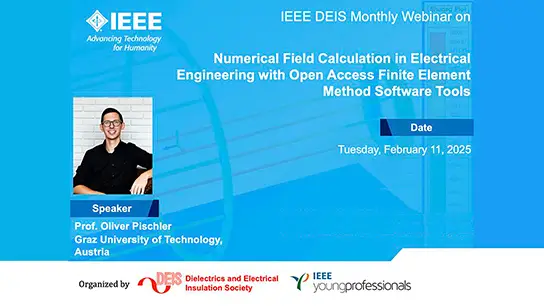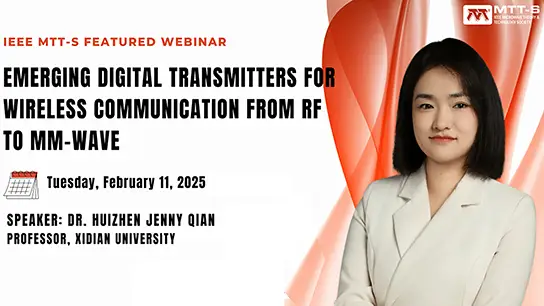-
Members: FreePES
IEEE Members: $25.00
Non-members: $40.00Pages/Slides: 74
Panel
12 Sep 2022
This panel session contains the following presentations:
1. Development of T-Shaped Antenna for RF Energy Harvesting System
Radio frequency (RF) energy harvesting will have a high potential to replace batteries and improve lifespans in energising low-power devices. In this case, the critical problem is battery wastes lead to the pollution of the land and water underneath. Radio frequency is an alternative way to extract energy from the environment and converts it into electrical energy for energizing low-power electronic circuits directly or is stored for later use. This research involves designing and simulating the working antenna model for RF energy harvesting system using CST Suite Studio software. This research analyses and validates the efficient performance of RF signals captured by antennas into RF harvesting systems. Other than that, simulations are performed to obtain a frequency value of 900 MHz with a targeted return loss gain of less than -10 dB. The antenna simulation results show that the frequency response at 897.86 MHz achieves the return loss at value of -26.097 dB. The proposed T-shaped antenna can generate high efficiency of up to 899.36 MHz in the experimental analysis and obtain the value of return loss gain of -26.838 dB. The performance proves that the T-shaped antenna is compact and easy to handle. Therefore, the antenna can be used as the front-end section to harvest energy in the harvesting system. Antenna can also be conveniently applied for RF energy harvesting applications. Finally, it is concluded that the proposed energy harvesting antenna can be used to provide power on demand for shortrange sensing applications.
2. Impacts of Residential PV and BESS on Distribution Network Performance
Residential photovoltaic (PV) generation and battery energy storage systems (BESSs) are environmental-friendly and can help power network customers to save on electric bills. The penetrations of residential PV and BESS increased significantly in recent years. However, the operation of residential PV and BESS is out of the control of power system operator. The behaviors of PV and BESS that maximize customers' interest may lead to the adverse effect on the power network. This paper investigates power network performance under multiple scenarios, considering the load variation, PV generation variation, BESS charging/discharging and the location and penetration of PV and BESS. The simulation results show that the voltage drop/increase along the feeder can reach around 0.06 p.u. under extreme conditions. The BESSs located at the downstream of the feeder have more influence on the power network performance.
3. A Solution to Microgrid Unit Commitment Problem Considering Renewable
Optimal operation of micro grids (MGs) with high integration of renewable energy sources (RESs) has become challenging because of the intermittency nature of RESs. MGs energy management with battery energy storage system (BESS) is thus important to reduce the uncertainty. In this study, a novel coot algorithm is proposed to solve the MG energy management problem. The attained results show that the inclusion of the BESS unit can considerably minimize the operating costs up to 6%. Furthermore, the simulation results show the effectiveness of the suggested MG energy resources management approach.
4. Forecasting Solar Irradiance Using Hybrid Stationary Wavelet Transform- Quaternion Valued Neural Network with a Softplus AMSGrad Learning Algorithm
Efficient use of solar energy requires reliable forecasting values. In this paper, we propose a forecasting system combining the stationary wavelet transform and quaternion-valued neural networks (SWT-QVNN) and use it to forecast solar irradiance. In addition, a quaternion variant of the softplus AMSGrad learning algorithm is developed and used in optimizing the developed neural network. The proposed system was tested using irradiance data from two cities Abu Dhabi, UAE and Tamanrasset, Algeria. It did reduce RMSE by more than 60% compared to the baseline model that uses a real-valued neural network.
1. Development of T-Shaped Antenna for RF Energy Harvesting System
Radio frequency (RF) energy harvesting will have a high potential to replace batteries and improve lifespans in energising low-power devices. In this case, the critical problem is battery wastes lead to the pollution of the land and water underneath. Radio frequency is an alternative way to extract energy from the environment and converts it into electrical energy for energizing low-power electronic circuits directly or is stored for later use. This research involves designing and simulating the working antenna model for RF energy harvesting system using CST Suite Studio software. This research analyses and validates the efficient performance of RF signals captured by antennas into RF harvesting systems. Other than that, simulations are performed to obtain a frequency value of 900 MHz with a targeted return loss gain of less than -10 dB. The antenna simulation results show that the frequency response at 897.86 MHz achieves the return loss at value of -26.097 dB. The proposed T-shaped antenna can generate high efficiency of up to 899.36 MHz in the experimental analysis and obtain the value of return loss gain of -26.838 dB. The performance proves that the T-shaped antenna is compact and easy to handle. Therefore, the antenna can be used as the front-end section to harvest energy in the harvesting system. Antenna can also be conveniently applied for RF energy harvesting applications. Finally, it is concluded that the proposed energy harvesting antenna can be used to provide power on demand for shortrange sensing applications.
2. Impacts of Residential PV and BESS on Distribution Network Performance
Residential photovoltaic (PV) generation and battery energy storage systems (BESSs) are environmental-friendly and can help power network customers to save on electric bills. The penetrations of residential PV and BESS increased significantly in recent years. However, the operation of residential PV and BESS is out of the control of power system operator. The behaviors of PV and BESS that maximize customers' interest may lead to the adverse effect on the power network. This paper investigates power network performance under multiple scenarios, considering the load variation, PV generation variation, BESS charging/discharging and the location and penetration of PV and BESS. The simulation results show that the voltage drop/increase along the feeder can reach around 0.06 p.u. under extreme conditions. The BESSs located at the downstream of the feeder have more influence on the power network performance.
3. A Solution to Microgrid Unit Commitment Problem Considering Renewable
Optimal operation of micro grids (MGs) with high integration of renewable energy sources (RESs) has become challenging because of the intermittency nature of RESs. MGs energy management with battery energy storage system (BESS) is thus important to reduce the uncertainty. In this study, a novel coot algorithm is proposed to solve the MG energy management problem. The attained results show that the inclusion of the BESS unit can considerably minimize the operating costs up to 6%. Furthermore, the simulation results show the effectiveness of the suggested MG energy resources management approach.
4. Forecasting Solar Irradiance Using Hybrid Stationary Wavelet Transform- Quaternion Valued Neural Network with a Softplus AMSGrad Learning Algorithm
Efficient use of solar energy requires reliable forecasting values. In this paper, we propose a forecasting system combining the stationary wavelet transform and quaternion-valued neural networks (SWT-QVNN) and use it to forecast solar irradiance. In addition, a quaternion variant of the softplus AMSGrad learning algorithm is developed and used in optimizing the developed neural network. The proposed system was tested using irradiance data from two cities Abu Dhabi, UAE and Tamanrasset, Algeria. It did reduce RMSE by more than 60% compared to the baseline model that uses a real-valued neural network.
Chairs:
Dr. Pauzi Abdullah


